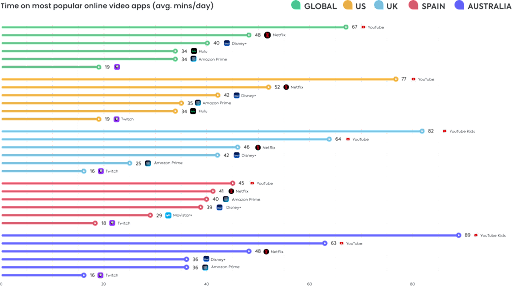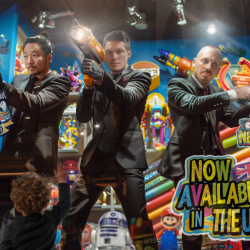Trends and marketing strategies today are largely shaped around Gen Z. But just as the seasons change, so do the youth demographics driving culture. With the last of Gen Z to graduate in 2030, it’s time brands started considering the new kids on the block.
Enter: Gen Alpha (2010-2024). Predicted to reach a population of 2 billion by 2025, this generation is on track to be the largest in world history. Brand-literate and tech-fluent, they receive their allowances in virtual currencies, seamlessly bridge digital worlds and many will live to see the 22nd century. By 2029 their economic footprint is anticipated to reach £4.32tn — almost as much as millennials and Gen Z combined. Even now, 81% of Gen Alpha influence a staggering $500 billion in family purchases annually. Understanding Gen Alpha presents not just the opportunity to forge lifelong loyalty with future consumers, but a gateway to their millennial parents.
Here are three ways brands can crack the code to Alpha engagement:
Bury the tween branding
For decades tween fashion has heralded a seminal time of self expression. For a ten-year-old me in the mid ‘00s, Tammy Girl’s jelly shoes were the height of cool. The kids these days are more discerning. Last year Piper Sandler reported that teen shoppers spent 19% more on skin care and 33% more on cosmetics than the year prior. TikTok’s well documented the recent epidemic of ‘Sephora Tweens’ destroying testers in pursuit of the latest Drunk Elephant products. The platform is awash with Gen Alpha influencers participating in ‘Get Ready With Me’ videos, opening PR packages and showing off their Starbucks orders.
Perhaps this is an inevitable consequence of online homogeny. Whilst teens of yesteryear pored over age-specific publications like Seventeen, the algorithms of today indiscriminately expose products meant for older audiences to all — and from pimple patches to Pillow Talk Cream Blush, today’s tweens want to engage in online culture. ‘Skincare is what kids [my 11-year-old daughter’s] age talk about, even those without social media,’ Dermatologist Kristen Knoll told The Business of Fashion. ‘This information percolates and you start finding kids hanging out at Sephora even when they aren’t buying anything. They just want to look at it.‘
Brands like Glow Recipe and Byoma have already cottoned on, curating bright packaging and playful copy that strategically appeals to younger audiences. Bubble’s ambassador program involves Alpha fans in their ideation processes. With Alphas shopping at the same stores as their millennial parents and Gen Z siblings (think Lululemon, Target, Nike, Aerie) many retailers now stock sizes small enough for preteens. This shift reflects the significant impact of social commerce. ‘The currency of [Gen Alpha’s] world is influence,’ says Mark McCrindle, the social researcher who coined the term ‘Gen Alpha’. ‘They intuitively know what will work, what will gain leverage, what will get good results.’
What we can learn…
Don’t patronise them. Gen Alpha’s brand maturity indicates a desire to be taken seriously. Employ age-agnostic marketing strategies that speak to them authentically.
Prioritise peer influence. Recommendations from cohorts hold weight. Look for opportunities to partner with young influencers or involve them in development.
Provide places for play. The pandemic has limited physical spaces. Is there a gap for brands to differentiate by creating in-store, interactive and memorable experiences?
Speak the language of streaming
It should come as no surprise that ‘the iPad generation’ possesses an intimate relationship with technology. Whilst we consider Gen Z as digitally native, Alphas are the first generation to be socialised in a digital-first world.
In their 2023 report Razorfish revealed that 43% of children own a tablet before the age of six. 47% are given their first laptop around eight, and most (58%) receive their first smartphone by ten. Whilst early access to these devices may seem to act as virtual babysitters, 72% of millennial parents told Google they use YouTube to connect to their children’s worlds. The study also revealed that 3 in 4 millennial parents are open to videos from brands when seeking parental advice, and 72% use YouTube to make better child-related purchasing decisions.
This parental trust and the convenience of free, on-demand content means YouTube is a mainstay for Gen Alpha. It’s their go-to source for learning, entertainment and self-discovery. Morning Consult’s 2024 report notes half of Alphas stream video daily. Wielding YouTube’s search bar, they autonomously curate personalised journeys — and from slime videos to science experiments, this generation are tech-empowered micro-experts. ‘I watch [aeroplanes] fly around at airports. It’s really fun and interesting,‘ one 12-year-old told Qustodio in 2023. ‘I create videos that I post on my YouTube channel,’ said another 11-year-old. ‘My devices let me connect with people, make new friends, and create videos for people to enjoy.’

With Gen Alpha spending most of their time on YouTube worldwide, it’s become their primary path to brand discovery. According to Razorfish, 51% of Gen Alphas first hear about brands through YouTube. A 2019 Wunderman Thompson report found that 55% of kids aged six to sixteen want to purchase items displayed by their favourite YouTube personalities. 12-year-old Ryan Kaji, who started vlogging toy reviews at just four years old, is a celebrity amongst Alphas. His YouTube channel, Ryan’s World, now approaches 37 million subscribers. Brands are tapping into these audiences through digital ads within these channels and sponsorship deals.
In 2017 Pocket.watch launched a line of toys named after Ryan’s World. ‘Kids are choosing to watch the branded content and then staying for the [ad],’ Sales VP Julia Moonves told AdAge. Brands have a unique opportunity to build rapport and relationships with Alphas through the creators they know, respect and trust.
What we can learn…
Leverage YouTube. YouTube is Alphas’ primary path to brand discovery. Tap into trends or sponsor age-appropriate influencers to create video-first content.
Fun for the whole family. 78% of parents seek videos that give them ‘something to talk about’ with their kids. Create co-watchable content that appeals to all.
Educate, entertain and interact. Audience interaction with kidfluencers is on the rise. Offer interactive experiences that feel relatable and fun, not purely promotional.
Gamify your offerings
For Gen Alpha, games aren’t just a source of entertainment; they’re a nascent incubator for social interaction, problem-solving and self-expression.
In their Global Gamer Study 2023, Newzoo revealed a whopping 94% of Gen Alpha play video games. The immense popularity of games such as Roblox (204M monthly users), Minecraft (167M) and Fortnite (229M) emphasises the importance of connection, co-operation and creativity for Alphas through gaming experiences. In addition to smartphones being their primary gaming device at 81%, Alphas are more likely to play on PCs or consoles than older generations. Their interests are also more varied; on average, baby boomers play 2.8 genres, whilst Alphas plays six. When it comes to in-game purchases, Alphas are motivated by access to exclusive content (38%) and buying characters (29%).
70% of Generation Alpha also watch video games in addition to playing them. GWI’s data revealed that livestreams are among the top three types of content Alphas consume. Twitch is enormously popular with Alphas for its unique community interactivity. Top streamers host live Minecraft and Sims build challenges, where interactive polls and chat functions steer gameplay choices in real time. Unboxing videos offer a similar thrill, with the surprise element and anticipation building excitement for the product reveal.
Gaming is no longer a subculture; it’s mainstream. By incorporating interactive and engaging mechanics into their offerings, brands can create a sense of fun and foster brand loyalty with a generation defined by digital fluency and an inherent love of gamified experiences.
Several brands are already capitalising on this trend, blurring the lines between virtual and physical commerce. Nikeland is a Roblox metaverse where users can customise avatars with virtual Nike items, unlock free UCG content and compete with friends in mini-games. Walmart sells Roblox gift cards in-store that allow buyers to access exclusive virtual items online. Marvel, DC and Star Wars have all made signature characters available as skins to purchase and play as on Fortnite.
What we can learn…
Embrace diverse platforms. Go to where they already are. Decentralised spaces like Twitch offer Alphas the opportunity to be their true selves and connect authentically.
Create shared experiences. Contests with UGC challenges offer Alphas the opportunity to showcase their creativity and build brand affinity.
Leverage their creativity. Alphas value exclusive content and creating their own worlds. Find ways to offer unique gamified customisation in offerings.
Featured image: Daiga Ellaby / Unsplash


























